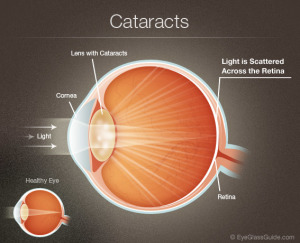Back to basics – all about cataracts
What is a cataract?
A cataract is a clouding of the natural lens of the eye, which causes a decrease in vision. A cataract is likened to the lens of a camera becoming fogged up. Cataracts are quite common, and are the leading cause of vision loss in people aged over 40 years.
The natural lens of the eye in a young individual is nice and clear. Over time, in everyone, this clear lens will gradually change in colour and clarity, eventually becoming harder for light rays to pass through and thus harder to see through. When this clouding begins to impact on vision, we call this a cataract. Generally, cataracts develop slowly and painlessly, so vision and lifestyle can be affected without realising it.
What is the Lens?
The natural lens of the eye is the part of the eye used for focussing. It is a clear structure that is similar to the lens of a camera. The lens is located behind the iris (the coloured part at the front of the eye). The lens bends light as it enters the eye, so that it forms a clear picture on the retina at the back of the eye. The lens is capable of changing shape, and widens to focus on closer objects, and narrows to focus on items further away.
How does a cataract form?
Most cataracts are related to ageing, and cataracts are very common in older individuals. There are some factors which increase the likelihood of developing a cataract, such as diabetes, smoking, UV exposure and use of certain medications such as steroids.
Are there different types of cataracts?
Yes, there are several different types of cataracts. Some cataracts are small, and do not interfere with vision. Other cataracts are large, and cause significant changes to vision.
The most common form of cataract is the age related cataract. Other types of cataract include: metabolic, traumatic, paediatric or infantile cataract. A metabolic cataract is a cataract that forms due to diabetes and a few other select diseases. A traumatic cataract can develop after an eye injury, chemical burn or radiation. A paediatric cataract, also known as an infantile cataract, or a congenital cataract, develops in the eye of a child usually under the age of 5 years.
Do cataracts form in both eyes?
Cataracts can form in both eyes at a similar rate of maturity, both eyes at very different rates of maturity, or in one eye only. your ophthalmologist will be able to tell you whether you have cataracts in one or both eyes.
How do I know if I have a cataract?
If you have noticed a change to your vision, it is important to see an eye health professional – an optometrist or an ophthalmologist. They will examine your eyes to determine the cause of your vision change and whether you have a cataract. Cataracts generally cause a decrease or change in vision, halos (or rings) around lights, problems with glare, poor night vision, and occasionally double vision. Another sign of cataracts is frequent changing of prescription glasses, and the sudden ability to read without glasses in people over the age of 55 years.
If you are over the age of 40, we recommend having your eyes examined by an ophthalmologist or optometrist every year, even if you are not experiencing any eye problems. Many eye diseases do not have any symptoms until they are quite advanced and significant vision has already been lost. Regular eye examinations can ensure any ocular changes are detected early to help retain your vision.
How is a cataract treated?
In the early stages of cataract development, the vision can sometimes be managed and somewhat improved with glasses or contact lenses. Once the cataract matures, cataract surgery is usually necessary. There are no non-surgical treatments for cataracts (such as eyedrops or laser treatment). Cataract surgery is the only treatment for visually significant cataracts, and is a safe, effective and painless procedure.
Stay tuned for more information over the coming days on cataracts, cataract surgery and cataract FAQ’s



